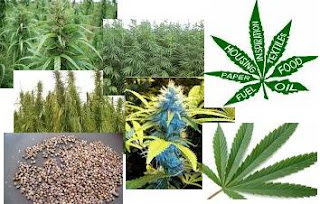Hemp as a fuel.
Hemp is an excellent source of high quality cellulose biomass. Biomass fuels are clean and virtually free from metals and sulphur, so they do not cause nearly as much air pollution as fossil fuels. Even more importantly, burning biomass fuels does not increase the total amount of carbon dioxide in the Earth's atmosphere. The use of biomass will reduce acid rain and reverse the greenhouse effect.
Hemp is an excellent source of high quality cellulose biomass. Biomass fuels are clean and virtually free from metals and sulphur, so they do not cause nearly as much air pollution as fossil fuels. Even more importantly, burning biomass fuels does not increase the total amount of carbon dioxide in the Earth's atmosphere. The use of biomass will reduce acid rain and reverse the greenhouse effect.
Hemp is the #1 producer of biomass per acre in the world. Biomass energy expert Lynn Osburn estimates that 1 1/2 to 3 1/2 million acres of hemp could replace all of Canada's fossil fuel demands.
The hemp plant will reach a height of up to 5m(16 feet) and sink a main tap root down 2m(6 feet). This tap root will draw nutrients from deep in the soil and make them available to subsequent crops when the hemp leaves are shed on the soil, returning up to 60% of the nutrients it takes. This extensive root system also helps to alleviate the problem of soil compaction.
The hemp paper-making process requires no dioxin-producing chlorine bleach and uses 75% to 85% less sulphur-based acid. The paper mills now in place would require little conversion in order to switch from wood to hemp pulp.
Hemp produces the strongest, most durable natural soft-fibre on earth. Hemp cloth is stronger, more durable, warmer, and more absorbent than cotton.
Hemp grown in Canada will require no herbicide or insecticide applications. Hemp fibre breathes and is recyclable, unlike petroleum-based synthetic fibres. A fully mature hemp plant may contain 1/2 of it's dry weight in seed.
Hemp seed has an oil content of 34%, more than any other seed. Hemp seed oil is second only to whale oil in quality and has the same burning qualities and viscosity as #2 grade heating oil, without any of the sulphur-based pollutants.
Hemp was NOT banned because it was a harmful drug. Hemp was banned because it was a competitive threat to the wood products industry and newly developed synthetic fibers that were patentable, and therefore more profitable than hemp. Corporations that profited from the demise of hemp propagated a smear campaign against hemp by claiming that marijuana use was a major drug problem (it was not) and that marijuana use caused people to become extremely violent-- another falsehood. Unfortunately, these false claims went unchallenged and hemp was outlawed in 1938.


